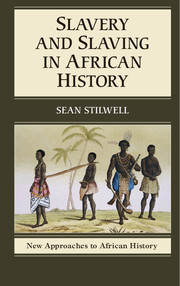5 - Slavery and African Economies
Published online by Cambridge University Press: 05 June 2014
Summary
Introduction
In 1685, Michel Jajolet de La Courbe visited a slave agricultural estate of a powerful official of Waalo, a Wolof state in what is now Senegal. These large farms produced food crops that fed the Wolof political elite and were exchanged for livestock and animal products. La Courbe noted that after his arrival on the estate, he found the man he sought “in the middle of his field with his sword at his side and his spear in his hand, which encouraged his people in their work.” He noted that the slaves “numbered more than sixty, and were naked. Each one held a small rounded iron hoe with a cutting blade at the end, which was attached to a handle and which they used to cut down the weeds and work the soil at the same time, working only the top surface of the soil. All of this was accomplished to the sound and rhythm of the energetic music of six griots, who played drums and sang. It was a pleasure to watch them move as if they were possessed, quickening or slowing the pace of their work as the beat of the drums rose and fell.”
In South Africa, by the middle of the eighteenth century, many slaves worked the wheat and wine farms that surrounded Cape Town. At the height of the harvest, slaves performed numerous tasks. According to O. F. Mentzel, who observed these farms in the 1730s, “Every grape cutter at the vintage has a small basket, made of thin split Spanish reed standing next to him which when full, is carried to the pressing house ... a ‘balie’ or barrel ... when is pierced at the bottom and along the sides with holes made with a half-inch drill, stands on a trestle in a second larger barrel, without holes except for a bung hole, through which the must that is trodden out, passes into a pail or barrel placed beneath it. A slave stands in the perforated barrel, holds on to a short piece of rope stretched above him and treads the grapes with which it is filled with bare feet.”
- Type
- Chapter
- Information
- Slavery and Slaving in African History , pp. 124 - 175Publisher: Cambridge University PressPrint publication year: 2014

